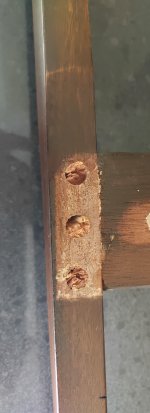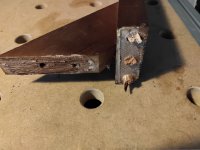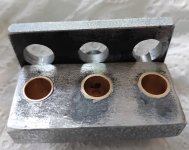fastbikenz
Member
- Joined
- Jul 11, 2015
- Messages
- 13
My wife's mother has some fine dining chairs, probably around 50 years of age. The wood is some type of mahogany.
Anyway the inevitable has happened and the joints between the rear legs and the rails are busted. There are 3 dowels on each side, around 8mm in diameter, reinforced with a triangular block. IMO, the design is quite weak as there is no stretcher so the joint tends to rack, and bingo, all of the dowels have broken.
Now I could attempt to drill the dowels out and redo them, but where is the fun in that, and knowing my luck the dowel holes will not line up. So I'm thinking a Domino joint would be superior as there will be more material and a greater glue surface.
The legs and the rails are around 21mm thick, the rails are around 50mm high from the bottom to where some fancy profiling starts.
Using the rule of one-third thickness, a domino around 7mm would be ideal, but does not exist, so I'm likely to use an 8mm.
However the width of that domino is only 22mm, I think a wider one (up to around 30mm) would provide a stronger repair.
An alternative would be to use a 10mm domino, which has a width of 24mm, but risks splitting the leg or rails as the wall thickness would be less than 6mm.
The third option would be to use the 8mm cutter to make a mortise around 30mm wide and then make my own domino/spline to fit.
Any feedback and advice would be good, as I'd like to get this job done next weekend in time for festive gatherings at the end of the year.
View attachment 1
Anyway the inevitable has happened and the joints between the rear legs and the rails are busted. There are 3 dowels on each side, around 8mm in diameter, reinforced with a triangular block. IMO, the design is quite weak as there is no stretcher so the joint tends to rack, and bingo, all of the dowels have broken.
Now I could attempt to drill the dowels out and redo them, but where is the fun in that, and knowing my luck the dowel holes will not line up. So I'm thinking a Domino joint would be superior as there will be more material and a greater glue surface.
The legs and the rails are around 21mm thick, the rails are around 50mm high from the bottom to where some fancy profiling starts.
Using the rule of one-third thickness, a domino around 7mm would be ideal, but does not exist, so I'm likely to use an 8mm.
However the width of that domino is only 22mm, I think a wider one (up to around 30mm) would provide a stronger repair.
An alternative would be to use a 10mm domino, which has a width of 24mm, but risks splitting the leg or rails as the wall thickness would be less than 6mm.
The third option would be to use the 8mm cutter to make a mortise around 30mm wide and then make my own domino/spline to fit.
Any feedback and advice would be good, as I'd like to get this job done next weekend in time for festive gatherings at the end of the year.
View attachment 1



